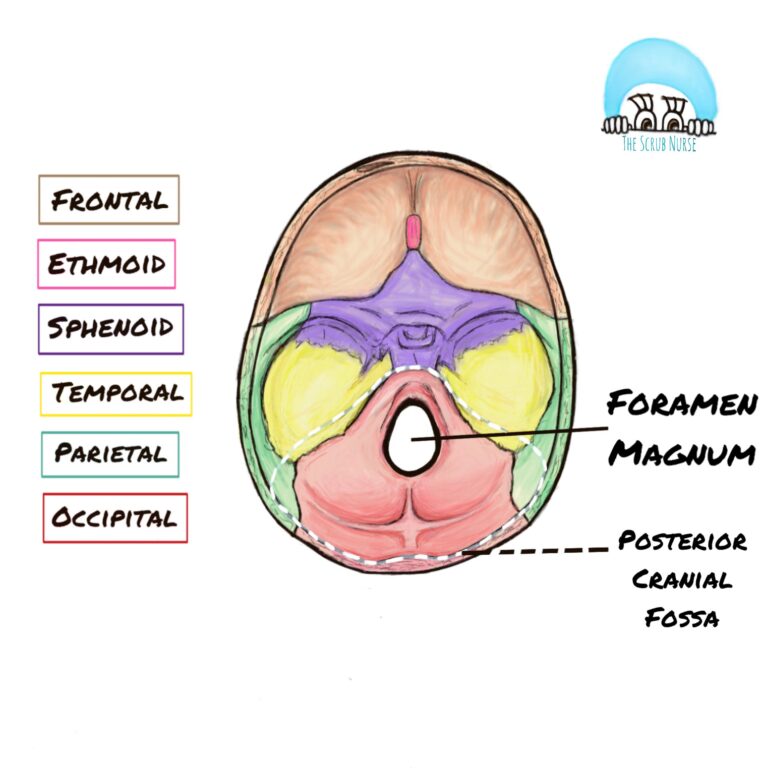Anatomy review:
Before answering our main question, let’s review the anatomical terms and structures associated with fontanelles.
- Skull is the skeletal structure of the head that protects the brain and supports the face. It is divided into two parts:
- The cranium (or neurocranium) – part of the skull whose bones form the cranial vault (roof of the skull; also known as skull vault, skullcap, or calvaria) and the cranial base (base of the skull); together they encase and protect the brain;
- The facial skeleton (or viscerocranium) – it supports the soft tissues of the face, determining our facial appearance.
- Fontanelles are membraneous areas located in the cranial vault that have not yet ossified;
- Cranial sutures are strong, elastic and fibrous joints (synarthroses) that join the bones of the skull.

Human Skull
In this post we are going to understand the importance of Fontanelles and cranial sutures, when they close, and what can go wrong if the closure occurs too early.
Why are Fontanelles and cranial sutures important?
Both are very important as they promote brain growth. How? Because brain expands faster than the surrounding bones do, having flexible sutures and membraneous areas (fontanelles) in diverse places of the cranial vault will allow the rapid stretching of the cranium, while brain volume increases.
Therefore, the late fusion of Fontanelles and sutures allow the postnatal growth of cerebral volume. See picture below to acknowledge the brain volume during different stages of life in comparison to an adult sized brain.
Another role of Fontanelles and sutures is at birth. If birth occurs by natural delivery, the baby’s head is larger in comparison to the rigid and narrow birth canal. To adapt to that situation, the baby’s large Fontanelles and the flexible sutures allow skull compression and bone overlapping during delivery period.
Additionally, Fontanelles and sutures also protect brain from minor impacts of head, as during infancy and childhood babies are learning how to hold their head up, roll over, and sit up.
How many Fontanelles and cranial s sutures are we born with?
Generally, the humans are born with 6 Fontanelles:
- anterior or bregmatic
- posterior or lambdoid
- sphenoidal or anterolateral (right & left side)
- mastoid or posterolateral (right & left side)
Regarding cranial sutures, the main ones are:
- Metopic or frontal
- Coronal
- Sagittal
- Lambdoid
- Squamosal or squamous (right & left side)

Newborn’s skull – top view

Newborn’s skull – lateral view
What happens when Fontanelles and cranial sutures ossified?
Once they fully ossify no further expansion of the braincase is possible.
When do Fontanelles and cranial sutures close?
Generally Fontanelles close in this order:
I. Posterior Fontenelle (around 2 – 3 months of age)
II. Sphenoidal Fontanelles (around 6 months of age)
III. Mastoid Fontanelles (around 6 – 18 months of age)
IV. Anterior Fontenelle (around 1 – 3 years of age)
Regarding sutures, the closure happens later in life, usually they remain patent and capable of growth until early adulthood (late 30’s).
And if the ossification occurs too early?
Some children may suffer from premature fusion of sutures and Fontanelles, a condition called Craniosynostosis.
Consequently, the growth pattern of the skull changes and it may result in abnormal shaped head and/or developmental impairment (due to brain development being affected).
Did you know that?
- Sometimes babies are born with additional Fontanelles. They may present the sagittal Fontanelle and/or the metopic Fontanelle;
- The presence of sagittal Fontanelle is clinical associated to Down’s Syndrome and other anomalies.
References:
carta – AGE OF FONTANELLES / CRANIAL SUTURES CLOSURE
Radiopaedia – Cranial vault
Teach me Anatomy – Bones of the Skull
GFMER – Anatomy of the Foetal Skull
Medline Plus – cranial sutures

